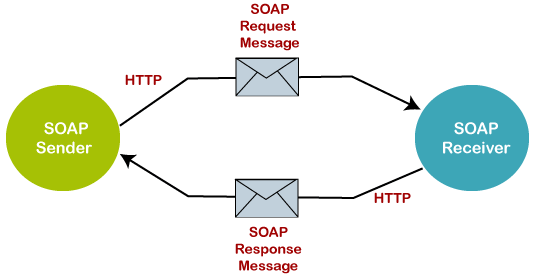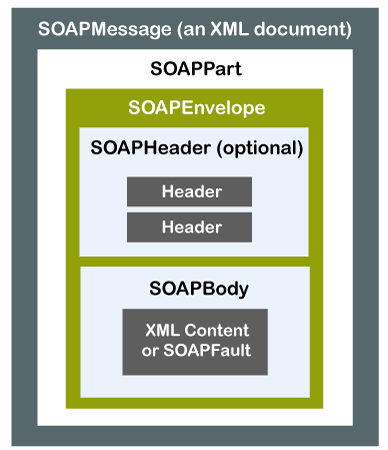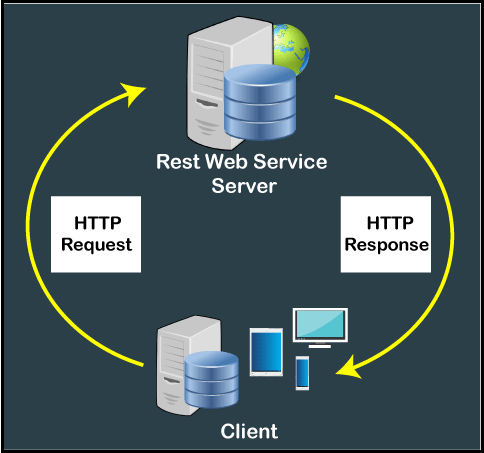Introduction of SOAP and REST Web Services
SOAP Web Services
SOAP stands for Simple Object Access Protocol is a network platform used in a web service to exchange or communicate data between two different machines on a network. It uses the XML format of data to transfer messages over the HTTP protocol. In Web services, SOAP allows the user request to interact with other programming languages. In this way, it provides a way to communicate between applications running on different platforms (Operating system), with programming languages and technologies used in web service.

SOAP Message:
The SOAP message contains the following information in the XML format, as given below.
- It contains information about the message structure and instructions during processing on the network.
- The SOAP contains an envelope that represents the starting and end of the message in the XML format.
- In the message, the header is an optional element that contains application-specific information such as authentication, authorization, and payment etc.
- A fault element is an optional element that shows an error message during the processing of the information.
Characteristics of SOAP
- It is an open standard protocol used in the web service to communicate via internet.
- It is used to broadcast a message over the network.
- It is used to call remote procedures and exchange documents.
- It can be used on any platform and can support multi-languages. So, it is a platform and language independent.
- It uses the XML format to send messages over the HTTP protocol.
- The structure of a SOAP message consists of an envelope, header, and body element.
SOAP Building Block
The SOAP building block describes what XML data is sent to the web service and client application. The following diagram represents the SOAP building block.

SOAP Envelope: Envelope is used to define the start and end of the SOAP message. It contains the details of the SOAP message. It is an important element of the XML documents.
SOAP Header: It is an optional element in which the header contains the credentials information such as authorization, authentication, etc. is used during the processing of a SOAP message.
SOAP Body: It is an important element of the SOAP message that contains request and response information in the XML format. It defines the actual content of the message to be sent between the client and the webserver.
SOAP Fault: The SOAP Fault element is an optional element used to display an error message encountered during the transmission of a SOAP message. It holds the status of SOAP messages and errors.
The following are the sub-elements of the SOAP Fault element.
| Sub Fault Element | Description |
|---|---|
| <faultcode> | It is used to identify the fault code in the SOAP message. |
| <faultstring> | It is used to provide the human-readable description of the error. |
| <faultactor> | It is an optional element in the SOAP Fault that indicate the fault occurred during processing if the message. |
| <detail> | It is used to hold the application-specific status error of the Body element. |
SOAP Structure:
The following code represents the SOAP structure.
SOAP Request Example
Advantages of SOAP
The advantages of the SOAP protocols are:
- It is recommended by the W3C consortium for the web services and application programming interface to communicate with the client application.
- It is a lightweight communication protocol used for exchanging data between two machines over the network.
- It is a platform-independent operating system that can run on Linux, Windows and macOS.
- SOAP uses a default protocol to send the message over a network, and all web applications also support it.
- It has an XML format that includes an envelope, header, body, and fault element as a SOAP message during the message’s processing
Disadvantages of SOAP
The disadvantages of the SOAP protocols are:
- SOAP is used only XML format data in web service, whereas JSON and other lightweight formats are not supported by it.
- It is slow because it uses XML format, whereas the payload for a simple string message is large.
- There are no security features in the SOAP specification.
- There is no state reference for the remote object in the SOAP client.
REST Web Service
REST stands for REpresentational State Transfer. It is an architectural style that provides standards between computer systems on a web service. It is a set of constraints used to create a lightweight, scalable, and maintainable web service that facilitates easy communication. It is a set of constraints used to create a lightweight, scalable and maintainable web service that makes easy communication with each other. All web services are based on the REST; hence it is called a RESTful service. The purpose of developing a RESTful web service is to make the web service more effective. The Roy Fielding develops it in 2000, who also developed the HTTP protocol. It does not depend on a specific protocol to use, but it’s used HTTP/HTTPS.

REST Characteristics
- It is a Stateless server.
- It supports JSON and XML
- It is simple than SOAP.
- It has well-maintained documentation that reflect each change in the architectures of the REST.
- It is a simple approach to build the client and server service.
- It follows standard protocol such as HTTP, HTTPS and FTP.
- It provides a way to connect with server-side applications.
- It is based on architectural style for designing simple, lightweight, and distributed web services compared to SOAP.
- Examples of REST Systems are -Google Glass API, Amazon web services, Atom, Tesla Model S.
Constraint and the Principles of REST
- Client-Server
- Stateless Server
- Cacheable
- Uniform Interface
- Layered System
Client-Server Model:
- Client: Client machines or users send a special request to the webserver and wait for the web server’s response.
- Server: Server is the collection of web resources that provides different services to multiples clients. It receives multiples requests from the client machines and responds to that request to the client.
Stateless Server: Each request generated from the client-side to the server should contain all the necessary information easily understood by the server.
Cache Response: Any response received from the web server must verify whether the response is cacheable or not. A cache helps both the clients and the servers respond faster to not generate traffic to the web server. For example, when the client repeatedly asks the same request on the server, which is already responded by the server. And again, the same request will go to the server, which increases traffic throughout the network.
Uniform Interface: It is the technique that represents how the REST web service is worked with HTTP protocol.
- Resource Identifier – URL/URI
- Resource Representation and Manipulation – It defines which the URL identifies data resources. And that data can be manipulated directly from the client URL requested to the Server.
- It helps to manage communication between client and server.
Layered System
- It is used to accommodate extra layers like proxy servers, firewalls, gateways, and caching system.
- Code on Demand: It is an optional code on-demand constraints that allow the client to request and execute the server’s code. Furthermore, the server can deploy new features to the clients’ machine.
HTTP Method of REST web service
GET: It is used to fetch information from the resource server.
POST: It is used to create or insert new information on the resource server.
DELETE: It is used to remove the records or information from the resource server.
PUT: It is used to manipulate or update the existing records on the server.
Advantage of REST
- REST web services are fast as compared to SOAP because it has no restriction like SOAP. It consumes less bandwidth and resources.
- It is an architectural style for creating lightweight, scalable and maintainable web service.
- It is a language and platform-independent web service that can be written in any programming language and run on Windows, Linux and Mac.
- REST web service helps the client machine access different formats of data such as HTML, JSON, XML, etc. from the webserver.
Difference Between SOAP and REST Web Service
| SOAP Web Service | REST Web Service |
|---|---|
| It stands for Simple Object Access Protocol. | It stands for REpresentational State Transfer. |
| It is XML based messaging protocol. | It is not a protocol. It is an architectural style for distributed hypermedia system. |
| It needs more bandwidth and resources for better web performance. | REST requires less bandwidth and resources as compared to SOAP. |
| SOAP enforces XML as a message format. | It is not specifically applied that the message format must be XML or JSON, etc. |
| It has not great performance as compared to REST. | It has better performance as compared to SOAP, less CPU intensive, lesser code, etc. |
| SOAP defines its security. | REST inherits security measures from the underlying transport. |
| It does not support error handling. | It has built-in error handling. |
| SOAP is a heavyweight XML protocol that requires more coding to send a message. | It is a lightweight, scalable and maintainable. |
| It cannot be cached. | It can be cached. |
| SOAP messages are wrapped in an envelope and sent to any transport mechanism such as SMTP, FTP, HTTP or any protocol. | It relies on the HTTP protocol for communication between two machines. |
